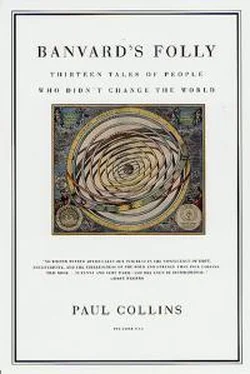"the air in the tube was by no means foul or disagreeable," though "here and there a strong flavour of rust was encountered."
Inventors became ambitious again. In the Crystal Palace Exhibition of 1864, the public boarded a quarter-mile-long line set up by the Pneumatic Dispatch Company and overseen by the company's chief engineer, T. W. Rammell.
Afterward, Rammell proposed a huge London system of atmospheric subways, running thirty trains an hour. The sum of l135,000 was raised from investors, and groundbreaking was held on October 25, 1865.
Pneumatic postal schemes met with even greater success. Lines snaked between London post offices and businesses, and over the next thirty years, ninety-four lines with more than thirty-four miles of tubing crisscrossed the city. The London Times sunnily predicted that "between the pneumatic dispatch and the subterranean railways, the days ought to be fast approaching when the ponderous goods vans which fly between station and station shall disappear forever from the streets of London."
Pneumatic systems roared to life in every major city in Britain, as well as in Berlin, Paris, and Vienna. One was even proposed across the Swiss Alps. None, though, were being built in America--at least, not at first. But that was about to change.
Before he laid a single foot of railway track, Alfred Beach had seen an even faster and cheaper means of transport: pigeons.
The pigeons belonged to his father, Moses Beach, owner of the scrappy tabloid the New York Sun. One of Moses's first acts as a publisher was building a massive pigeon house on the roof of his building; his winged legions carried news back from Albany and Washington, D.c., giving him a slight edge in a publishing world so rough-and-tumble that Sun and rival Herald newsboys would knock each other down in the streets.
Alfred inherited his father's publishing savvy, but he was also deeply interested in sciences. And so in 1846, at the age of twenty, he and prep school roommate Orson Munn bought out a failing magazine called Scientific American. Early on, Beach had a masterful insight: he added a patent law business to the magazine offices. With nearly every New York inventor passing through his doors, Beach had an endless supply of breaking technology news. He had patent papers to write stories from before the Patent Office examiners in Washington had even seen them.
Beach traveled down there every month to Patent Office hearings, and was the best friend that inventors in this country had. It is easy to see how this empathy arose. Beach was a brilliant inventor himself, having designed one of the first working typewriters when he was only twenty-one years old. His greatest passion, though, was reserved for atmospheric railways. He pored over London papers and magazines as they came off arriving boats, saving any article mentioning the successes of pneumatic transit. Soon, the idea began to germinate within him: why not build one in Manhattan?
If you stood in just the right spot on 14th Street on September 16, 1867, you could see the future. It had arrived in Manhattan with the opening of the American Institute Fair, and it had visitors craning their necks to look heavenward: suspended from the ceiling of the Armory was a gigantic wooden tube, 107 feet long and six feet wide, with an open carriage sliding back and forth inside. Delighted visitors clamored to get aboard, a dozen at a time, and by the end of the exhibition it had carried more than 100,000
Manhattanites.
Near the train was another exhibit, an ingenious postal pneumatic system consisting of street-level lampposts with built-in mail slots for letters bound uptown and downtown. A letter dropped in would waft down to a bin far below the street. This bin hung just over a pneumatic tube; a car roaring by would smack open the bin, dumping out its contents into the mail car, which then rocketed onward with the cargo. It was to be far cheaper than conventional Manhattan haulage: for what was spent each year on cargo horses in Manhattan, the pneumatic system could be laid down in every street three times over.
Presiding over these wonders was Alfred Beach. The passenger line had been built in just six weeks by Beach, and it was already unlike any train ever seen before. For one thing, you could hang it from a ceiling. A new laminating process used by Beach meant that the tube was only a one-and-a-half-inch thick wooden shell, light and strong enough to be hung almost anywhere, and flexible enough to be bent into outlandishly arcing and curving designs.
Beach had fantastic visions on offer to exhibition visitors--of a future landscape of pneumatic trains burrowing into the depths of Manhattan, and then rearing up aboveground to lace the urban airspace, arcing out in gentle curves to hang from the sides of buildings, even passing on stilts right over the rooftops. The metropolis would be a writhing mass of silent, slithering tubes, pulsing with encapsulated citizenry hurled along at up to 100 mph. Passengers embarking from City Hall could arrive at Jersey City in just five minutes, Central Park in eight minutes, or Harlem in fourteen minutes.
"Almost anything is possible to modern engineering," marveled one bedazzled reporter from the Brooklyn Daily Eagle, "providing money enough is furnished."
With this great truism in mind, Beach spent much of 1868 lobbying the legislature in Albany, exhorting readers in the pages of his magazine, and issuing The Pneumatic Dispatch, a lavishly illustrated booklet describing his dreams for the city. But Beach was not the only one making plans. His father's old rival Horace Greeley was also lurking the halls of the capitol; he and Cornelius Vanderbilt, among others, had hatched their own railway scheme for the city. Vanderbilt and his minions were to be sorely disappointed, though, for not only did the legislature turn them down, it also gave Beach permission to build a small pneumatic mail line by City Hall.
Beach was going to get his chance to prove himself at last. He hurriedly drew up a charter and scrambled to issue $5 million in stock, and on August 1, 1868, the Beach Pneumatic Transit Company was born. And then, for a while ...
nothing happened.
Or so it seemed. Beach knew he had to move very carefully. Vanderbilt and others were waiting to pounce on him at the first sign of actual construction, ready to halt work with court accusations of disruptions in water and sewage service. And the teamsters at the stagecoach and cargo companies, furious at their looming obsolescence, would love nothing better than to crack a few heads at the construction site while cops pointedly looked the other way.
There was no groundbreaking ceremony, then--quite the opposite. Beach had assembled his team in the basement of a clothing store and sworn them to utter secrecy as they burrowed down into the earth. The telltale piles of dirt they excavated were whisked away in sacks in the dead of night. Tons of brick, marble, and wood and an entire piano were all smuggled down through the store's basement, all without a soul on the street knowing it.
It helped that the team had something of a secret weapon. The ever-inventive Beach had designed a special tunneling shield for them, a massive honeycombed metal disk propped up with hydraulic jacks; under pressure, the shield extruded dirt out the back, which was then dug out and carted away. By cranking up the pressure of the jacks on either side, the excavators could make the tunnel curve to the left or right. The Beach shield was to become standard excavating equipment years later, but right now, Beach's workers were the only people in the world to have one--and they couldn't even tell anyone about it.
Even those in on the secret, though, might have noticed something puzzling about the proceedings. The bill passed by the legislature had allowed Beach to build two fifty-four-inch tubes under Broadway, a limit that effectively ruled out passenger traffic. What Beach was laying track down for, though, was a single tunnel with a 108-inch bore--which just happened to be big enough to carry passengers.
Читать дальше











